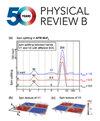平面磁场下石墨烯基Josephson结的各向异性超电流抑制和恢复
IF 3.7
2区 物理与天体物理
Q1 Physics and Astronomy
引用次数: 0
摘要
我们报道了一种可调谐的约瑟夫森结,它是由包裹在具有超导铌触点的WSe2中的双层石墨烯带形成的。我们通过测量磁场诱导的干涉图样和表现为夏皮罗步骤的交流约瑟夫森效应来表征结,检查电流相关的滞后和结动力学。后者可以通过温度、栅极电压和磁场来调节。最后,我们研究了在面内磁场作用下的超电流演变。值得注意的是,我们观察到超电流与面内磁场的方向有很强的各向异性。当磁场方向与电流方向平行时,随着磁场方向的增加,超电流受到抑制,并表现出恢复,而当磁场方向与电流方向垂直时,超电流几乎不受影响。我们认为这种各向异性是由超电流干涉对结几何形状的依赖引起的。2025年由美国物理学会出版本文章由计算机程序翻译,如有差异,请以英文原文为准。
Anisotropic supercurrent suppression and revivals in a graphene-based Josephson junction under in-plane magnetic fields
We report on a tunable Josephson junction formed by a bilayer graphene ribbon encapsulated in WSe2 with superconducting niobium contacts. We characterize the junction by measurements of the magnetic field–induced interference pattern and the AC Josephson effect manifested as Shapiro steps, examining current-dependent hysteresis and junction dynamics. The latter can be tuned by temperature, gate voltage, and magnetic field. Finally, we examine the evolution of the supercurrent when subjected to in-plane magnetic fields. Notably, we observe strong anisotropy in the supercurrent with respect to the orientation of the in-plane magnetic field. When the field is parallel to the current direction, the supercurrent is suppressed and shows revivals with increasing magnetic field, whereas it remains almost unaffected when the field is oriented in a perpendicular direction. We suggest that this anisotropy is caused by the dependence of supercurrent interference on the junction geometry. Published by the American Physical Society 2025
求助全文
通过发布文献求助,成功后即可免费获取论文全文。
去求助
来源期刊

Physical Review B
物理-物理:凝聚态物理
CiteScore
6.70
自引率
32.40%
发文量
0
审稿时长
3.0 months
期刊介绍:
Physical Review B (PRB) is the world’s largest dedicated physics journal, publishing approximately 100 new, high-quality papers each week. The most highly cited journal in condensed matter physics, PRB provides outstanding depth and breadth of coverage, combined with unrivaled context and background for ongoing research by scientists worldwide.
PRB covers the full range of condensed matter, materials physics, and related subfields, including:
-Structure and phase transitions
-Ferroelectrics and multiferroics
-Disordered systems and alloys
-Magnetism
-Superconductivity
-Electronic structure, photonics, and metamaterials
-Semiconductors and mesoscopic systems
-Surfaces, nanoscience, and two-dimensional materials
-Topological states of matter
 求助内容:
求助内容: 应助结果提醒方式:
应助结果提醒方式:


